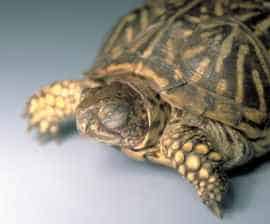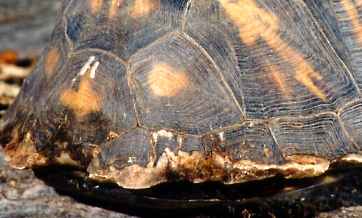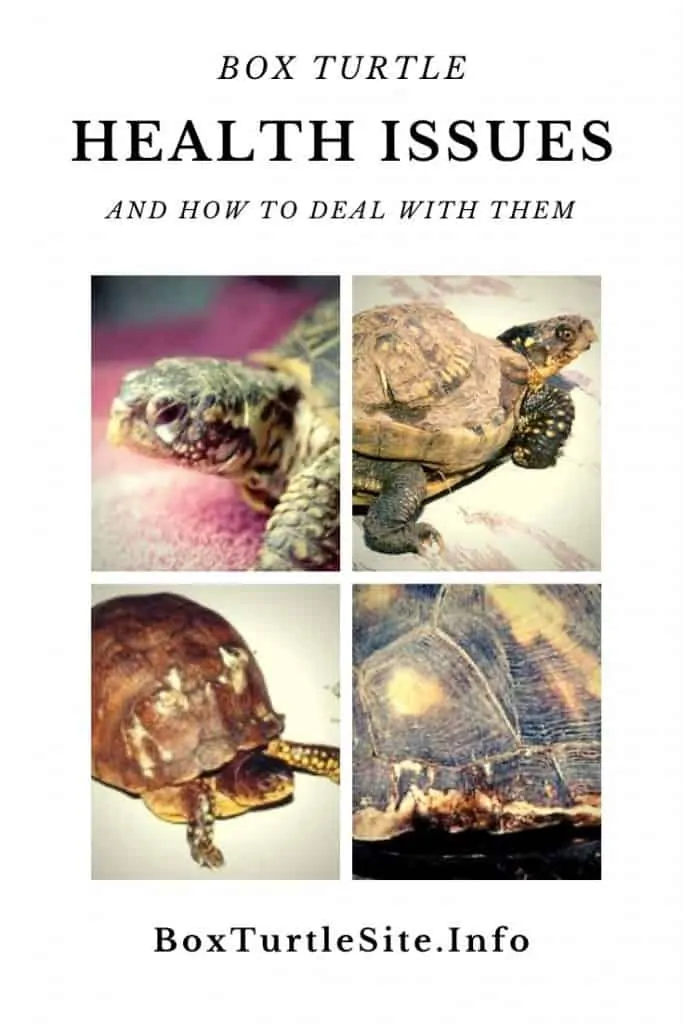This page provides an overview of common illnesses and medical issues that can affect your box turtle. We’ve broken down the list into two categories. Box turtle diseases you can take care of yourself including tips and box turtle illnesses that require a veterinarian.
Generally, if you keep your box turtle in a clean and proper environment and feed it well, you will have few medical problems. Box turtles living outdoors will get plenty of sunshine and exercise. Both are important for good health. Sunshine activates cells in the turtle’s skin and shell to produce vitamin D3. In addition to the symptoms of the most common box turtle diseases, we will also give you some tips for the best box turtle health care.
Exercise helps keep the turtle’s bones and muscles strong. Without exercise, the bones may become weakened and constipation problems can occur. But accidents happen, and parasites, bacteria, and fungae are everywhere just waiting for an opportunity to take advantage of a weak or stressed-out turtle. It’s good to know when you can do something to help the turtle yourself or when it’s necessary to take it to a reptile veterinarian.
Box Turtle Health Care Overview
Since this is a detailed post, you can find the main contents here. Just click on the links here, if you are looking for a quick advice about a certain box turtle disease.
How to know if a box turtle is sick or injured?
Box Turtle health problems you can take car of yourself
– Scratches and cuts
– Insects or fly eggs on skin
– Irregular shell growth
– Shell rot
– Overgrown nails
– Turtle won’t eat
– Closed eyes
Box Turtle diseases that require a veterinarian
– Respiratory illness
– Swollen or sealed eyes and turtle won’t eat
– Mouth rot
– Lumps on cheeks
– Cracked shell or dog bite
– Internal worms
– Abnormal behavior from female
– Paralyzed legs
– Overgrown beak
– Organ disease
– Organ prolapse
Box turtle euthanasia
How to find a box turtle veterinarian
Important: Avoid salmonella when dealing with a sich box turtle
How to set up a hospital tank for your sick box turtle
Disclosure: This post contains affiliate links. At no extra cost for you, we may receive a commission if you purchase products mentioned below.
How to know if your turtle is sick or injured?
Try to observe your turtle daily. Regularly look at its shell and skin for any abnormalities, cuts and lumps. Watch it when it eats, when it is in the water and as it walks around.
You will begin to know your box turtle and its normal behavior so when it does get sick, you’ll be able to notice the change in behavior and activity. Weigh the turtle, and do it often enough so you can tell if it begins to lose weight.
Occasionally look at the turtle’s feces. Is it well formed and is the food being digested? Turtles don’t get a fever, or start to moan or make faces. The first signs of illness are usually a change in eating pattern or activity levels.
If the turtle has a respiratory infection, it may start to gasp or breathe with its mouth open. It may blow bubbles from its nose or it may have diarrhea. If it has worms, it will begin to lose weight or you might see white worms in the feces. None of these symptoms are very noticeable unless you are observant and make it a habit to check on the health of your turtle.
If you have a sick or injured turtle, consider setting up a hospital tank in order to better manage treatment and observation. You can find details on how to do that further down.
Box turtle health problems you can take care of yourself
Superficial scratches and cuts
If the turtle is on antibiotics, soak it two times a day in tepid water. The turtle should not be fully submerged in water. Many antibiotics have by-products that are toxic to the kidneys, so ample hydration is necessary to aid in eliminating the toxins.
Many minor injuries can be treated from a homemade first-aid kit. It should contain disinfectant solution, for example, chlorhexadine or betadine solution, triple antibiotic ointment, cotton tipped applicators, surgical tape and gauze pads.
Clean all cuts, even ones on the carapace and plastron, with disinfectant. Use diluted chlorhexadine or a weak, diluted betadine solution. Clean daily until healing is well along. If the wound is deep, it should be covered with a Band-Aid or gauze and surgical tape and kept indoors away from egg laying flies. In case you can see any signs of infection, like redness, pus or a foul smell, apply antibiotic ointment immediately. If the wounds do not look better in a few days, take the turtle to a veterinarian for stronger medication. The turtle should see a vet immediately if the injuries are caused by dog or raccoon bites. These types of injuries often expose bone and expert attention is warranted.
Insects or fly eggs on skin
Remove chiggers, ticks or fly eggs with tweezers and clean the area with disinfectant and apply antibiotic ointment. Remove any source of insects from the enclosure or keep the turtle indoors until the insects are eliminated.
Don’t keep food in the enclosure for more than an hour or two. Clean and protect any open wounds on the turtle quickly so flies won’t lay eggs on them. These flies are attracted to the smell of blood and flesh. If larvae or maggots are already under the skin and eating away at flesh, it is better to see a veterinarian about removing them as the wound may be larger than what is observed and shots may be necessary to combat secondary infections. Mites can be washed off with soapy water. Remove turtles to another location and place small pieces of pest strips that kill mites in the enclosure. Be sure to remove the strips before returning the turtles to the pen.
Irregular shell growth
Irregular shell growth may be the beginning of metabolic bone disease and can have serious long term effects for your box turtle.
The shell may look lumpy or grow only on one side or the head may look abnormal. Note the box turtle in the picture to the left cannot close it’s shell due to metabolic bone disease and has lost it’s tail when another turtle bit it. Also see the overgrown beak and long nails, all are signs of metabolic bone disease.

This is an indication that something about your turtle’s care is not correct or adequate.
Look at what you are feeding your turtle. Is it getting the proper kinds and amounts of food? Are you feeding it too much protein and fat? Are you giving it the correct amounts of vitamins and minerals? Is it getting enough sunlight? Changes in husbandry and diet will stop the deformity and stave off serious metabolic bone disease. On this page, you can find all information on the ideal box turtle diet and learn about the importance of the calcium and phosphorous ratio for a box turtle.
Box Turtle Shell Rot
Box turtle shell rot is caused by fungus or bacteria. The bacteria that cause shell rot, often enter small cuts or cracks in the plastron. Once under the keratin layer of the shell, bacteria begins to grow on the bone. Soon the keratin layer separates from the bone and exposes a smelly, slick area of shell rot.
The best way to prevent this is to clean and disinfect any cuts on the turtle’s shell. Check the turtle often for signs of shell rot. I apply triple antibiotic cream onto any cuts to shell and skin that appears to be infected. Also, keep the turtle’s living area as clean as possible. Remove all feces and uneaten food as soon as possible. Change the water daily. Don’t give bacteria a place to live and thrive.
Shell rot can be hard to detect in box turtles unless you inspect for it. If you find shell rot on your turtle, a vigorous regimen of cleaning and medication is necessary. Remove any peeling keratin from the area. The thin keratin layer usually pops right off if turtle shell rot is present but will be firmly attached to the bone in healthy areas. It will expose bone with bacteria growing on it.

Gently clean the area with dilute betadine or a chlorahexine cleanser and apply triple antibiotic cream to the area. Protect the area so it stays clean. Do this for several weeks or until the bone has had a chance to calcify. The bone is a living, porous material and will heal and protect itself if given the opportunity. Other diseases of the bone or blood can develop from turtle shell rot so it should be taken seriously and a vet consulted if the shell rot is extensive.
Overgrown turtle nails
The nails of wild turtles are worn down as they forage for food. However, our pets often don’t get enough exercise and their claws may grow so long that walking is impaired. Before the nails get too long you should trim them with a sharp pair of regular toenail clippers. Be sure to trim them a little at a time as the blood-filled quick of each nail can be easily cut.
As the nail shortened, the quick will also shorten or withdraw. Overgrown nails can also be caused by nutritional deficiencies. If there are several other symptoms such as an overgrown beak, soft bridge or shell, or dry peeling skin, you should take the turtle to a reptile veterinarian for diagnosis. Modification to its diet may be required to correct the problem.
Off Feed – Turtle not eating
Going off feed or not eating is a very common occurrence and is something that will probably happen to all box turtles sooner or later. What your turtle once loved and gobbled up with relish is now sniffed at, and with a quick flick of the head, the turtle turns away and will not have anything to do with the food.
You end up scrambling to find something else the turtle will eat with regularity. The best defense is to never let your turtle become fixated on one thing. Make each meal unique by adding one or two different food items each time. I always select a different fruit and protein at each meal. The vegetable and leafy greens may be the same from day to day for a week, but even that is changed frequently.
Turtles in the wild are seasonal eaters, meaning they eat what is available. There aren’t too many foods that are available all spring and summer. You should try to mimic the natural feeding habits of box turtles, especially if you have an adult that is wild-caught. Many turtles will not eat old food. Feed only the freshest food to your turtles. Fresh foods also have the most nutrition.
Be sure to check the temperature of the turtle. A cold turtle will not feed. The core body temperatures of a hungry turtle will be about 75-80° F (25° C). It sometimes takes a while for the turtle to reach this temperature, so feed the turtle after it’s had a chance to warm up.
Click here for more information on what to do when a box turtle doesn’t eat and here to learn about the required temperatures and humidity levels for your type of box turtle.
Turtle will only eat one thing
Another common lament I hear over and over is the turtle will only eat one thing. For example, the turtle will only eat bananas, or cantaloupe or beef.
Actually, this is a problem that is easy to solve, but it’s going to take some effort on your part to break the turtle of its addiction to one food. To do this, you mix of the turtle’s favorite food with other foods you want your turtle to acquire a taste for.
You simply chop all the food into tiny, tiny pieces and mix it well so the turtle cannot help getting a bite of what it doesn’t like with what it loves. Use a high portion of the favorite food initially, but during the weeks of retraining, reduce the amount of it until the turtle is eating a balanced diet. The process may take awhile but it is possible. A three-toed box turtle I have took two years to retrain. He now eats whatever I put out for him.
Closed eyes and turtle won’t eat
Shut eyes
If the eyes are shut and can’t be opened without soaking the turtle in warm water, then you may have the turtle in an environment that is too dry, or in bedding that is irritating its eyes.
Keep the humidity up by using a moisture retaining bedding and with daily misting of water. Place more plants in the enclosure. This way, the humidity will naturally regulate itself. There should be clean water available for the turtle to walk into anytime it needs to.
If your turtle is indoors, there may be additional considerations. Is there a draft on the turtle that is drying it out? What kind of substrate are you using? Is it something that is sucking the water right out of the turtle, such as shredded paper or corncob bedding? Use something that retains water like terrarium moss or orchid bark.
Don’t use cedar shavings or cedar bark as it contains harmful oils that are toxic to most reptiles and can cause swollen eyes, running nose and respiratory problems to box turtles.
Closed and puffy eyes
If the eyes are closed and puffy, or there is a discharge from the eyes or nostrils, this is not caused by dryness. In this case, take the box turtle to a veterinarian. The turtle may have a respiratory infection or vitamin A deficiency. Once the vet has diagnosed the illness and taken care of it, you need to make changes in your husbandry to ensure it doesn’t occur again.

Closed and sunken in eyes
If the eyes are closed and sunken in, the turtle may be suffering from severe dehydration. Take it to a reptile veterinarian for medical attention. You should never allow your pet turtle to develop this kind of condition. But you may come across it in a pet store. Complain to the store management if you think they are not taking good care of their turtles.
If you have various types of box turtles, make sure to keep them in separate habitats. Different species of turtles may be prone to different diseases and infect each other.
Box Turtle diseases that require immediate veterinarian care
Respiratory illness
Usually, respiratory illness needs to be cured with antibiotics. The symptoms of respiratory illness are labored breathing with the mouth open and mucous forms in the nose or mouth. The turtle will not eat. However some turtles can get the sniffles from environmental causes like cold water or from a draft. Check for these things and eliminate them. If the turtle is outdoors, bring it inside and place it in a “hospital aquarium”. Further down, you will find instructions on how to set up a hospital aquarium.
Swollen or sealed eyes and turtle won’t eat
If the eyes are swollen or sealed shut, they are probably filled with pus. A skilled reptile veterinarian will need to remove the hardened pus. You can try soaking the turtle in tepid water twice daily so the pus can soften. The turtle will rub its eyes under water, thus helping to clear the harden pus out of the eyes. This process can take a week. The eyes may still need antibiotic medication. Sometimes, injectable antibiotics are given to the turtle if the infection is severe. If the turtle is very weak, it may need to be hand-fed or forced-fed.

How to force-feed a box turtle
Use the following items:
- Small jar pureed chicken baby food
- Small jar pureed green beans baby food
- 1/2-1 cup water with Pedialite® Electrolyte Power
- 1/4 teaspoon cod liver oil
- 1 tablespoon calcium powder
Mix well and feed via syringe at a rate of 1.5 ml per 100 gms every 7 days. Veterinarians also have commercial syringeable food and can provide you with a syringe and stomach tube. The vet should show you how to feed by stomach tube before you try it on your own.
The most important information the doctor can give you is the probable cause for the swollen eyes. It could be a Vitamin A deficiency or a bacterial infection. Access to natural, unfiltered sunlight and a complete diet will reduce swollen eye occurrences. It’s important to correct the underlying problem so the turtle doesn’t get the illness again.
Box Turtle Mouth rot
Mouth rot is usually an opportunistic disease and affects a turtle that has a weak immune system. Often caused by a fungus or bacteria. Mouth rot on box turtles can look like cheesy white stuff growing on the tongue or palate, or it can look like hardened pus and dead skin around the mouth, or it can spot the tongue with red or black with blisters.
Take the turtle to a reptile veterinarian immediately. A veterinarian is needed to cure mouth rot, but after it is cured you need to check how you’ve been caring for your turtle and correct any problems. Are you giving it nutritious foods? Is its living area clean? Is it warm enough or too warm? Some turtles come out of hibernation with mouth rot, suggesting they weren’t healthy enough to go into hibernation. Never let a sick or underweight turtle go into hibernation. Keep it indoors and warm and fed all winter long.
Lumps on cheeks

Lumps on the one or both side of the turtle’s head are actually ear abscesses caused by infections of the middle ear. The lumps require lancing and removal of the infectious debris. Usually, the vet prescrives antibiotic shots as well. Some people do this procedure themselves, but I feel my pet turtles deserve to see a reptile veterinarian if they require any kind of surgery. Ear infections are often the result of prolonged low-grade respiratory infections and can be avoided if colds are detected early and properly treated. After removing the infected material from the ear, the turtle should spend some time in the hospital aquarium to help combat the infection.
Cracked shell or dog bites
Take the turtle to a reptile veterinarian immediately if any of the wounds appear to be deep or have entered the turtle’s body cavity. The wound needs to be thoroughly cleaned and all loose pieces stabilized or removed from the shell.

A vet will give the box turtle injectable antibiotics. Turtles can get a serious disease called peritonitis and septicemia from bacteria that enters the blood stream from dog bites and open wounds in the shell or skin. The first signs of the disease may be reddening or pooling of blood under the plastron. The vet may be able to repair the break with a fiberglass or epoxy patch. Keep the wounds clean until you bring the turtle to a vet. If the wounds are superficial, clean the shell damage with a chlorahexine cleaner several times a day.

Internal worms in box turtles
Every few weeks you should look at your turtle’s feces to see if it looks normal. It should look dark, firm, and not consist of undigested food. If it does not, take some fecal samples to a veterinarian for testing. The vet can tell you what type of parasite your turtle has and what will kill it.
Two common mammal de-wormers have proven toxic or fatal to turtles and should never be used. They are Ivermectin and Piperazine.
Abnormal behavior from female
A female turtle can become egg bound, a disorder which is life threatening. If you think your adult female has eggs and she has good nesting sites, yet she begins to pace and strain, stops eating and otherwise acts different, you should have her x-rayed for egg binding. A female just looking for a nesting site will also pace but will still eat. A veterinarian will sometimes induce expulsion of the eggs.
Box turtles with paralyzed legs
Immobile legs are a serious problem and can happen for several reasons. A veterinarian may be able to determine the cause. It could be a vitamin or mineral deficiency that affects the bones or nerve function. It could also be an injury, tumor or a birth defect. Sometimes it is reversible, most times it is not. The turtle may live if the paralysis is not degenerative.
If found this story of Pedro the box turtle very heartwarming. The poor turtle lost both its legs and veterinarians got back to moving with a new set of wheels. Check out the video here:
Overgrown beak
A veterinarian can file down an overgrown beak down with a high speed rotating file. Do not use nail clippers as that can crack the beak and palate. An overgrown jaw is usually caused by a diet of too soft foods. However, it is often one of the symptoms of metabolic bone disease and one of the causes can be improper diet.
Check to make sure your turtle’s diet has enough calcium and that vitamin D3 is supplied if the turtle is not living outdoors. A good source of calcium is cuttlebone and will also help keep the beak trimmed.
Organ disease
The kidneys and liver are susceptible to disease. Kidney failure can be caused by a diet too high in protein. Liver dysfunction may cause calcium to not be absorbed properly. Unfortunately, there isn’t much you can do about it once damage to the liver occurs. Liver damage can be caused from vitamin A overdose, medications, parasites, or prolonged ill health.
Organ prolapse
Organ prolapse is a life-threatening problem and a reptile veterinarian should see the turtle immediately. Prolapse can occur for various reasons and different organs may be involved; the intestine, cloaca, or penis being the most common. Male turtles will sometimes evert their reproduction organs while in water. They will stand tall on the hind legs and strain to evert and expand their penis.
This is normal behavior and the organ will retract in a few minutes. This is not organ prolapse. Organ prolapse will not retract into the cloaca and is dragged along as the turtle walks.
Symptoms of turtle organ prolapse
The turtle will often not be eating and may have spent a lot of time straining or digging prior to the prolapse. A turtle that is often constipated, or ingests bark or stones while eating may be more prone to prolapse, but this is just a guess. Be careful about accidental ingestion of flooring and make sure your turtle drinks often and has fiber in its diet so constipation won’t be a problem. I set my turtles in tepid water to observe them drinking and to induce them to defecate.
Are you new to box turtles and overwhelmed with the technical terms? Check out our A-to-Z glossary.
Box Turtle Euthanasia
Putting down a severely injured or sick animal is never an easy task, but sometimes it must be done to relieve the suffering of the animal. Box turtles can survive amputations and other serious injuries that other animals die from. Therefore, it is important to get the opinion of a reptile veterinarian before making any decision to euthanize.
He will also be able to perform the euthanization humanely if it becomes necessary to put the turtle down. Other methods of euthaization is not recommended for box turtles. Decapitation and gassing does not kill the turtle quickly enough to prevent suffering, and freezing is not a reliable or painless method of killing box turtles.
Finding a Veterinarian for a box turtle
You may be wondering how to find a veterinarian that is knowledgeable about turtles. Look online or in the phone book and call all vets listed. Ask them if they work with reptiles.
Ask if they are a member of the Association of Reptile and Amphibian Veterinarians.
Call the zoo and speak to the reptile keeper and ask him or her who they use as veterinarian for their reptiles.
Join a turtle club and find out which veterinarians the members recommend.
Box turtles are interesting animals to keep as pets and like all pets, deserve expert veterinary attention when they are sick or injured. They also need daily attention from us. If we take care of little problems, they may not become big problems. By anticipating problems, we can usually figure out a way to avoid them, and the results will be a healthy and long-lived pet.
Set up a turtle hospital tank
The hospital tank is simply a small indoor terrarium that will allow the keeper to give therapeutic care and pay closer attention to a sick or injured box turtle.
Use a 20 gallon, 30″ × 12″ × 12″ glass tank, or a large 31 gallon plastic container.
It should be spacious enough for the turtle to be comfortable, yet small enough to control temperature and humidity. If you use a glass tank, cover the sides with paper so the turtle cannot see out. Use a thick, clean towel as a substrate. Place shredded newspaper on one side of the tank as a hide. If the turtle is not suffering from an injury, you can use moist sphagnum moss instead.
Add a waterproof hide box in this area. Place a fluorescent UVB light fixture over the bedding side. Leave the lights on for 12 hours a day. If you are overwintering the sick turtle, keep them on for 14 hours a day. Provide a shallow water dish on the other side and change frequently. Place a heat lamp with 75 watt bulb over the water dish.
You can also buy a ready-made and equipped turtle habitat like the one below. But to keep a sick box turtle in this kind of housing, you still need to cover the sides with paper. Use moist sphagnum moss instead of water inside the tank.
Watch the temperature in the hospital tank
Maintain the temperature at 85° F (29.4° C) on the warm side and 75° F (23.9° C) on the cool side. If necessary, use a lower or higher wattage bulb to get the proper temperatures. Place a digital thermometer at the turtle’s level. You want the turtle warm but you don’t want to overheat it. If you have to keep the turtle inside for a long time, provide it with ZooMeds’ ReptiSun 5.0 UVB (TM) or Reptile D-Light (TM).
Use an infrared light bulb on one side of the hospital tank if overnight temperatures fall below 75° F (23.9° C). If the turtle has an open wound, use a screen over any tank or tub opening to prevent flies from getting in.
Change the newspaper bedding and towels daily (sphagnum moss should be rinsed frequently). There is little ambient humidity in the hospital tank if you use towels and newspaper, so it make sure to soak the turtle daily in tepid water (deep enough to be half-submerged).
If the box turtle feels better, good. But don’t try to cure the turtle yourself if it is breathing hard, gasping for air or blowing bubbles from its nostrils. You should take it to a reptile veterinarian.
Avoid Salmonella when taking care of a sick box turtle
Salmonella exposure is something all reptile owners should be aware of since it is a disease that can cause severe diarrhea and even death to children and people with weaken immune systems.
Some box turtles (as well as raw eggs, chicken, beef, flies) are carriers of the germ and can spread it to humans. Always wash your hands with an antibacterial soap after handling box turtles or any reptiles.
Never feed raw chicken or beef to turtles. Never let small children play with your turtles. They may stick their fingers in their mouths before you have a chance to tell them to wash their hands.
Never clean turtle items near food preparation areas, like the kitchen sink. Use an outdoor faucet and wash pan. If you keep in mind the need for cleanliness and hand washing and you will lessen the chances of Salmonella poisoning.
If you have any further questions about bux turtle health, let us know in the comment section below or check out the numerous questions we answered in the box turtle care FAQ section.
Pin for later (just click on the image):



8 thoughts on “Box Turtle Health Care and Common Diseases”
Comments are closed.